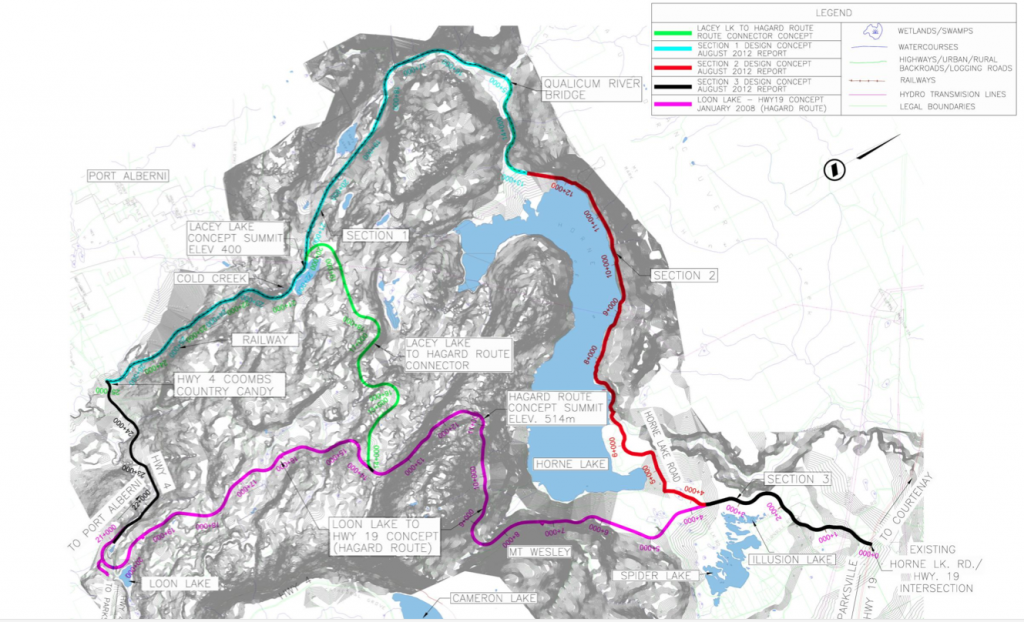The Port Alberni Port Authority has released two new reports reinvestigating options for the Horne Lake Connector.
Here are excerpts from their press release. They make no mention of rail.
The Port Alberni Port Authority (PAPA) is actively investigating initiatives to capture the economic opportunities that may be available to the community through leveraging the port’s capacity and natural geographic advantages.
In order for such growth to be most effective and efficient while having as low as possible safety, environmental and social impacts there must be investments made to improve our regional and local transportation infrastructure.
The Port Alberni Port Authority will continue to champion the community’s efforts to develop a comprehensive Transportation Infrastructure Strategy with senior levels of government in collaboration with local and regional government partners.
The new Highway reports make no determinations outside of basic travel times, on the cost-benefits of the new routes including but not limited to, safety, maintenance costs, environmental concerns, residents concerns, and actual traffic diverted from Highway 4.
In the opinion of VIFreightByRail, these new reports further degrade the case for the Horne Lake Connector. Not only are they only for a two-lane highway with no climbing lanes for trucks (implying greater costs once those are included), it also identifies multiple serious concerns with property owners, steep and unstable terrain, river and watershed crossings, and overall elevation (100m higher than Highway 4) that throw the safety and suitability of all of the routes in doubt. It also still does not include a solution to traffic going through the City of Port Alberni to the Port itself.
Unlike all of these proposals, the Railway remains an existing corridor with all the associated environmental and ownership concerns resolved. The Railway is a fraction of the cost to taxpayers. The Railway creates a direct connection between the Port Alberni Port terminal and North American and Asia Pacific shipping on day one without affecting and in fact reducing impacts on local communities and highways.
Hopefully these reports finally prove to the Port Authority and local politicians and business leaders that no matter how many angles they look at the Horne Lake Connector, the route is simply too costly with too many inherent problems to provide value to taxpayers and significantly increase capacity at the Port of Port Alberni.
The railway would provide all of the capacity needed to grow the Port significantly over the next 25 years while also being able take existing truck traffic off the roads and provide tourism and passenger opportunities.
A more detailed breakdown of the routes is below:
Here is a map of the routes considered (click for larger image):
Identifying the routes:
- Big Qualicum route starts at Coombs Country Candy, crosses the Big Qualicum River and passes directly beside residences on the north side of Horne Lake.
- The Lacey Lake route starts at Coombs Country Candy, traverses the area between Lacey Lake and Horne Lake and passes uphill from the residents on the south side of Horne Lake.
- The “Haggard” route starts at the top of the Hwy 4 near Loon Lake, and winds around the South side of Horne Lake.
The reports have only determined the routes to be ‘viable’ for further study and to be passed to the Ministry of Transportation. They make no recommendations.
Cost:
- Big Qualicum: $49.9 Million
- Lacey Lake: $63.3 Million
- Haggard (MoT2012 with Truck Climbing Lane): $65 Million
- Alberni Railway Spur (BCGov2010): $25.7 Million
Challenges identified in the reports:
(comments in italics)
- Impact on Intersection at Highway 19 – Building an interchange may be required.
This is an issue never identified before. If 3500 vehicles a day are diverted to the new route, the existing intersection may become a hazard on Highway 19. - Property Acquisition costs (“from the various owners”)
Owners may include timber companies, lake home property owners and others. - Truck Climbing Lane not included (including in cost)
In order to provide significant time benefit, climbing lanes will be required in for traffic to achieve acceptable average speeds. - No Geotechnical Investigations done
The report indicates concerns with steep terrain and missing data on whether terrain is dirt or solid rock. - Environmental Concerns with Big Qualicum River Crossing and Watershed
- Access roads for private homes on Horne Lake
No consultations have been held with home owners around the lake
Assumptions made in the reports:
(comments in italics)
- “Highway will meet current design standards for an 80km/hr design speed”
Design speed does not indicate actual average speeds achieved which could be very different given the terrain and geometry of all of the proposed routes. - “New highway will provide a safer route for motorists which will result in less collisions and fewer delays”
No basis for this claim is given. Lack of climbing lanes, higher elevations, and similar curves to the existing Highway and steep terrain identified in the report brings up serious concerns. - “fewer delays due to weather events”
This is based on less trees falling on the roadway. However, very few accidents, and thus delays, on Highway 4 are caused by trees on the roadway. The majority are vehicle accidents in adverse weather conditions. The significantly higher elevation of the Haggard/Lacey Lake routes (512m vs. 411m) should be of particular concern in winter. - “travel time for motorists travelling from the south island to the west coast will be equal or marginally less.”
Given the previous points, the travelling times from the South Island may not match the existing route.
